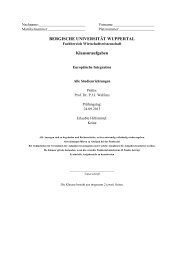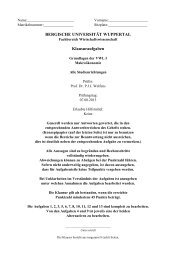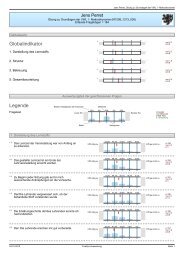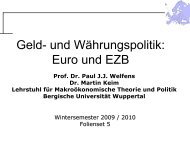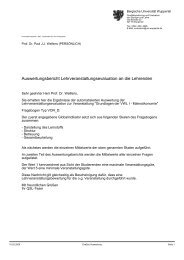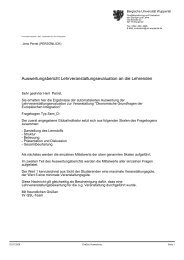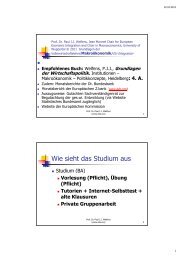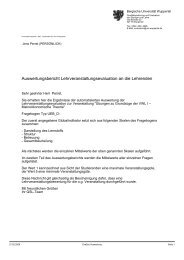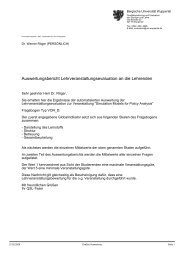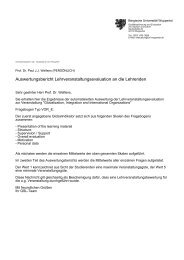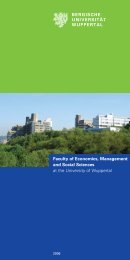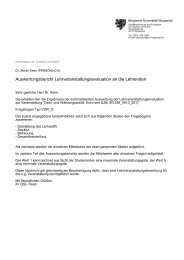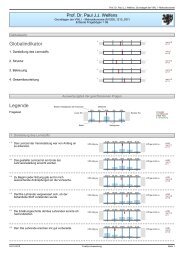UNIVERSITÄT POTSDAM - Prof. Dr. Paul JJ Welfens
UNIVERSITÄT POTSDAM - Prof. Dr. Paul JJ Welfens
UNIVERSITÄT POTSDAM - Prof. Dr. Paul JJ Welfens
Create successful ePaper yourself
Turn your PDF publications into a flip-book with our unique Google optimized e-Paper software.
works through better adaptation to specific consumer needs (higher utility) as well as<br />
through higher efficiency of production processes. The Internet allows a very broad<br />
variety of digital products and services to be sold in enlarged markets.<br />
When we turn to the selection environment, most studies have found tighter selection<br />
mechanisms to favor higher growth. Here the transparency enhancing effects of<br />
the Internet could be important.<br />
From a theoretical point of view, tighter selection does not necessarily prove<br />
more efficient because in this case a large number of product variants, which have incurred<br />
development costs, are selected out. However, this waste of resources may be<br />
compensated by long-run efficiency of fewer but superior products (see e.g.<br />
COHENDET / LLERENA / SORGE (1992) for a discussion of this fundamental problem<br />
in evolutionary economics). Market competition as one of several possible selection<br />
environments in an ideal sense weeds out all inefficient types of products in order<br />
to ensure the survival of the best-fitting alternatives. Then, in face of selection, generation<br />
of new products adapts to the characteristics of the successful variants. Therefore,<br />
it is essential for economic agents to learn quickly from the fate of successful as well as<br />
unsuccessful products on the markets and, then, to develop better variants which sell at<br />
higher prices or larger quantities. Thus, the particular strength of companies comes<br />
from learning adaptation. However, learning and adaptation are fundamentally pathdependent<br />
processes. That means, the probability to learn something useful will be<br />
much higher in areas where knowledge has already been accumulated in former times.<br />
This path-dependency of technological change and learning may be observed at the<br />
level of single companies, industries, regions and countries. It does not only explain a<br />
great deal of innovation but also the dynamics of division of labor and economic development.<br />
DOSI (1982) used this basic principle for a “theory” of technological change.<br />
Scientific and technological change is following “trajectories” until a “breakpoint”<br />
(radical change) disrupts the smooth and gradual development.<br />
The stock of accumulated knowledge does not only consist of scientific or otherwise<br />
codified and easily accessible findings but also of acquired “tacit” practical<br />
skills. Knowledge therefore has a “public” and a “private” part. Apart from a few really<br />
globalized and highly science-based technologies the main part of worldwide knowledge<br />
has a local character in that its geographical diffusion is limited in scope because<br />
of mobility barriers to human capital or skilled labor. Accordingly, empirical studies<br />
have found a lot of evidence that the ability to learn and to innovate greatly differs between<br />
sectors, regions and countries. See e.g. PAVITT (1984), PAVITT ET AL.<br />
(1987), DOSI / PAVITT / SOETE (1990) and GEHRKE / GRUPP (1994). Thus, stocks<br />
of technological knowledge differ in scope and character between economic entities<br />
over long periods of time. The Internet seems to be ambiguous since a high rate of ICT<br />
change implies relevance of private tacit knowledge; at the same time the global Internet<br />
facilitates development of public international knowledge within the triad.<br />
30



